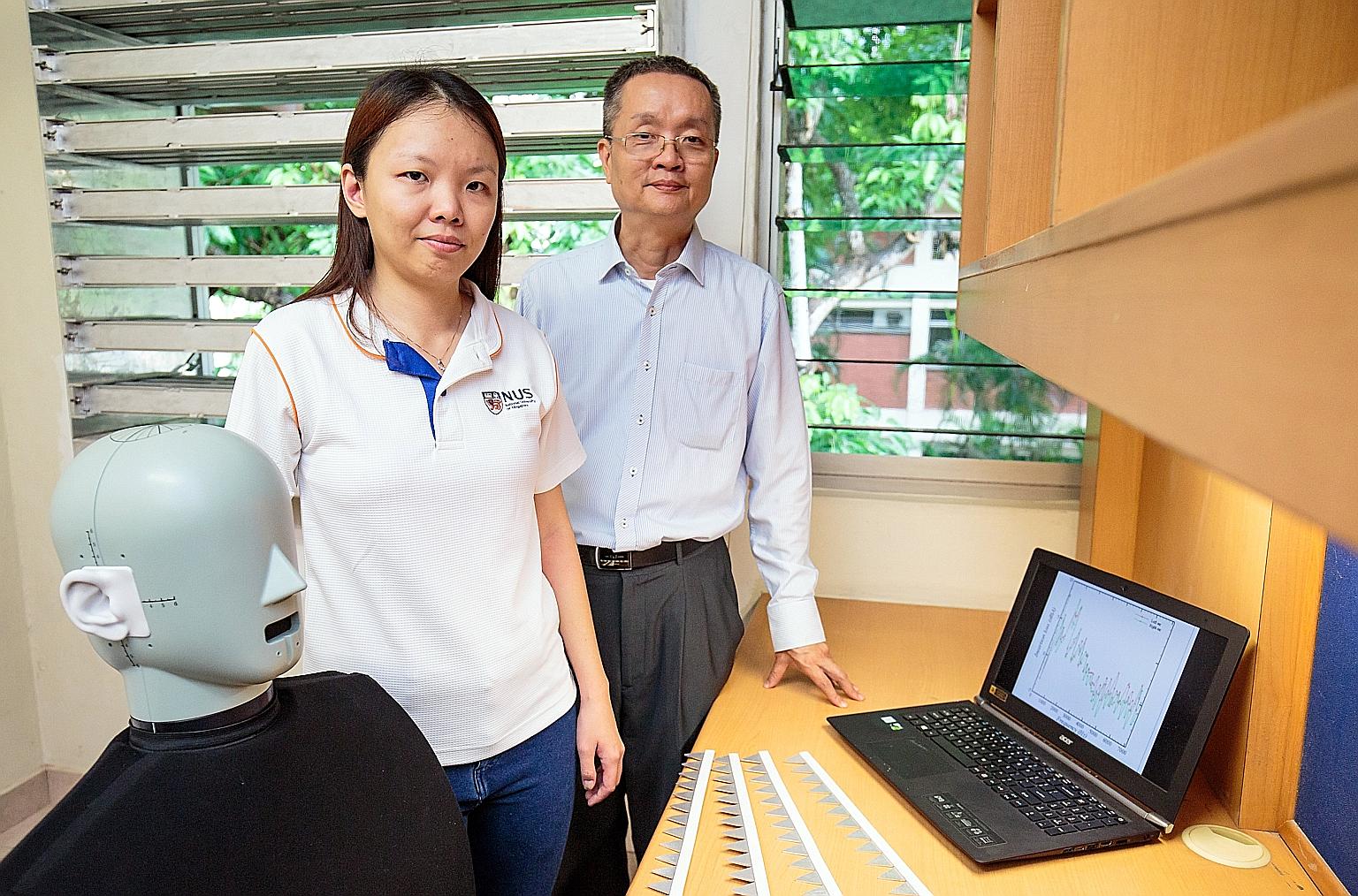Too noisy? Sonic crystal windows to the rescue
Team led by NUS prof develops windows that can halve noise pollution even while open
Sign up now: Get ST's newsletters delivered to your inbox

Prof Lee Heow Pueh (right) and Dr Lee Hsiao Mun and their team worked on the innovative windows. The human dummy helps create a realistic acoustic environment in experiments.
PHOTO: NATIONAL UNIVERSITY OF SINGAPORE
Lin Yangchen
Follow topic:
Researchers here have designed a new kind of window that could allow people to work better, sleep more soundly, breathe fresher air and save on electrical bills all at once.
Meet the noisebusters, a team of seven led by Associate Professor Lee Heow Pueh from the National University of Singapore's (NUS) Department of Mechanical Engineering, whose newly developed window can halve noise pollution even while open.
Their project is one of 13 supported by a total of $135 million in grants from the Ministry of National Development and National Research Foundation, under the Government's Land and Liveability National Innovation Challenge.
The idea is very simple.
It all started by accident - originating in a sculpture by Spanish artist Eusebio Sempere, consisting of a thicket of evenly spaced shiny tubes looking like organ pipes.
In 1995, Spanish researchers discovered that the sculpture altered the sound passing through it.
Measurements revealed that the neat rows of tubular structures trap sound waves of certain wavelengths. Similar - but much smaller - structures have been constructed to manipulate light waves.
Christened by researchers as "sonic crystals", these regularly spaced tubes have been used as noise barriers for years.
But their use in windows is new.
The NUS team, which started work on the project in late 2014, has filed a patent for its sonic crystal window.
The scientific principle is that parallel tubes separated by a given distance will be able to intercept sound which has a wavelength of twice that distance. For traffic noise which has wavelengths around 34cm, it means having tubes whose central axes are about 17cm apart.
Another factor is the diameter of each tube.
The larger the diameter, the wider the range of wavelengths the array of tubes as a whole is able to block.
There is yet another trick built in. Each tube is hollow, with slit openings along its length.
This acts as something called a Helmholtz resonator, which traps and dissipates lower frequencies, or pitches, of noise.
It gives "additional freedom in filtering off problematic frequencies" as the size of the resonator can be customised to absorb noise of a specific frequency from a particular machine, said Prof Lee.
Noise hitting the window can be further suppressed by giving the louvres a sawtoothed edge to encourage a phenomenon called destructive interference, where sound waves cancel each other out.
Similar noise-reducing structures are found on the wings of owls, renowned for their silent flight, and on the engine covers of the Boeing 787 Dreamliner.
While NUS students were away on vacation, Prof Lee's team tested a prototype of the window at Eusoff Hall, where students had raised concerns about noise levels at the Kent Ridge bus terminal nearby.
The scientists used aluminium for the tubes, which was easier to work with, but eventually the tubes could be made of a transparent material to make it easier to look out the window.
For traffic and construction noise, which have frequencies ranging from about 700Hz to 1,400Hz, the sonic windows can reduce loudness by up to half.
The team found the optimal design through computer simulations and field experiments.
Prof Lee said: "The objective of the study as required by the award is that we had to establish the solution for three things - a good balance of natural daylighting, noise mitigation and natural ventilation."
He added that the windows would save on air-conditioning and could even prevent the accumulation of germs in places like hospitals.
The project is a collaboration with the Building and Construction Authority (BCA) and National Environment Agency.
The BCA said the windows will be test-bedded in high-rise residential and office buildings at NUS' University Town, including Cinnamon College. The project is expected to be completed late next year, it added.
About five students and interns have also been involved in the project so far, undertaking tasks like equipment set-up and data analysis. "Education is always part of our mission, so whatever we do we always try to engage the students," said Prof Lee.
The researchers are now exploring ways to make portable versions of their invention, which Prof Lee said could be used as temporary screens for social events in HDB void decks, among other things.
He added that one company has already expressed interest in the portable sonic crystals and that the team is looking for more opportunities to commercialise the technology.

